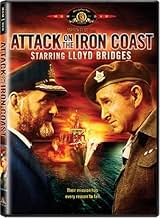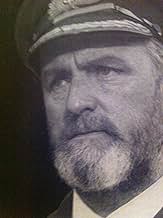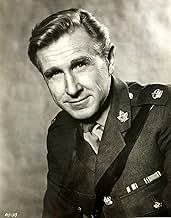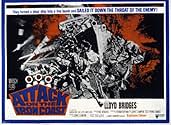IMDb RATING
5.5/10
851
YOUR RATING
During World War II, a commando leader named Major Jamie Wilson leads a group of soldiers on a suicide mission to destroy a Nazi naval stronghold on the French coast.During World War II, a commando leader named Major Jamie Wilson leads a group of soldiers on a suicide mission to destroy a Nazi naval stronghold on the French coast.During World War II, a commando leader named Major Jamie Wilson leads a group of soldiers on a suicide mission to destroy a Nazi naval stronghold on the French coast.
John Abineri
- German Gunnery Sergeant
- (uncredited)
Sean Barrett
- Radio Man
- (uncredited)
Victor Beaumont
- German Battery Commander
- (uncredited)
Peter Brace
- Commando
- (uncredited)
- Director
- Writers
- All cast & crew
- Production, box office & more at IMDbPro
Featured reviews
Paul Wendkos is an average director at best, but has the ability to turn a potentially terrible movie into a satisfying action flick. "Attack on the Iron Coast" is yet another low-budget entry in a series from Oakmont Production, and although it presents nothing new, but holds attention so well that the clichés are easy to overlook.
John C. Champion's script is a fictional takeoff on a real WWII event, much like his earlier and much worse "Submarine X-1". This time, the story is based on Mountbatten's raid on the dry dock at St. Nazaire, in which a ship laden with explosives crashed into the repair dock and destroyed important German repair facilities.
Lloyd Bridges ("A Walk in the Sun") plays Major Wilson (a takeoff on Lord Mountbatten), who's first commando mission in France turns into a shambles. But he is given a second chance when he plans an even riskier operation to destroy the German repair dock at LeClair (Ste-Nazaire). The only problem is that Captain Franklin (Andrew Keir, "Lion of the Desert") is opposed to the mission from the start, and the two must cooperate as the mission is a joint Army-Navy operation.
This film is really a mixed bag. What's good is really, really good and what's bad is really, really bad. Lloyd Bridges gives a sincere performance as Major Wilson, but his character isn't developed as much as I would have liked. We're treated two a two-dimensional hero who doesn't have any weaknesses; he brings to mind John Wayne's Colonel Kirby of "The Green Berets". His conflict with Franklin is the core of the movie and provides enough tension that the German enemies aren't needed until the final act.
The German characters are disappointing. We're treated to some very shallow characterizations which bring to mind the worst excesses of "Hogan's Heroes". The officers sit and watch dirty movies and become sated on fine wine and liquor while their subordinates bring in urgent reports of an approaching enemy ship. This is very unfortunate, because both George Mikell and Walter Gotell are very capable German actors who have had very good roles in the past - chiefly, "The Guns of Navarone", where they acted together in 1961. This really let me down. It would have been wiser to exclude German characters altogether and dwell on the commandos some more.
The action sequences are withheld until the final 20 minutes or so of the film and range from well-crafted to laughable. Scenes of British commandos dashing about in alleyways and dockyards are excellently staged and well-shot, even if they're very generic. The scenes of British minesweeper in the bay, however, feature some of the worst miniature work of the period. It's obvious that this feature had a low budget, because they aren't many extras or realistic explosions in the entire film.
Wendkos manages to keep things interesting by moving his camera fluidly and often shooting from high or low angles, giving the audience a unique perspective on the dialogue or action. The sets are all-top notch and the exteriors are very well-decorated. The German dockyard is expansive and really has a fresh, authentic feel to it and the various British war offices are equally believable.
"Attack on the Iron Coast" is nothing more than a routine, satisfying 90-minute film. There is nothing fresh and unique about it, but some fair acting and fast pace keep it engaging.
John C. Champion's script is a fictional takeoff on a real WWII event, much like his earlier and much worse "Submarine X-1". This time, the story is based on Mountbatten's raid on the dry dock at St. Nazaire, in which a ship laden with explosives crashed into the repair dock and destroyed important German repair facilities.
Lloyd Bridges ("A Walk in the Sun") plays Major Wilson (a takeoff on Lord Mountbatten), who's first commando mission in France turns into a shambles. But he is given a second chance when he plans an even riskier operation to destroy the German repair dock at LeClair (Ste-Nazaire). The only problem is that Captain Franklin (Andrew Keir, "Lion of the Desert") is opposed to the mission from the start, and the two must cooperate as the mission is a joint Army-Navy operation.
This film is really a mixed bag. What's good is really, really good and what's bad is really, really bad. Lloyd Bridges gives a sincere performance as Major Wilson, but his character isn't developed as much as I would have liked. We're treated two a two-dimensional hero who doesn't have any weaknesses; he brings to mind John Wayne's Colonel Kirby of "The Green Berets". His conflict with Franklin is the core of the movie and provides enough tension that the German enemies aren't needed until the final act.
The German characters are disappointing. We're treated to some very shallow characterizations which bring to mind the worst excesses of "Hogan's Heroes". The officers sit and watch dirty movies and become sated on fine wine and liquor while their subordinates bring in urgent reports of an approaching enemy ship. This is very unfortunate, because both George Mikell and Walter Gotell are very capable German actors who have had very good roles in the past - chiefly, "The Guns of Navarone", where they acted together in 1961. This really let me down. It would have been wiser to exclude German characters altogether and dwell on the commandos some more.
The action sequences are withheld until the final 20 minutes or so of the film and range from well-crafted to laughable. Scenes of British commandos dashing about in alleyways and dockyards are excellently staged and well-shot, even if they're very generic. The scenes of British minesweeper in the bay, however, feature some of the worst miniature work of the period. It's obvious that this feature had a low budget, because they aren't many extras or realistic explosions in the entire film.
Wendkos manages to keep things interesting by moving his camera fluidly and often shooting from high or low angles, giving the audience a unique perspective on the dialogue or action. The sets are all-top notch and the exteriors are very well-decorated. The German dockyard is expansive and really has a fresh, authentic feel to it and the various British war offices are equally believable.
"Attack on the Iron Coast" is nothing more than a routine, satisfying 90-minute film. There is nothing fresh and unique about it, but some fair acting and fast pace keep it engaging.
Just wanted to add further to the comment about this movie being based on Operation Chariot.
The purpose of the raid was to disable the only dry dock on the French coast that was large enough for the German battleship Tirpitz, sister ship to the Bismark. During this stage of the war, this was a very important consideration as the Tirpitz could of created a great deal of havoc if it where to get into the North Atlantic and attack the vital convoys that where keeping England in the war. The actual raid was a success. The dry dock and associated equipment was damaged so thoroughly that it no longer was a viable option for the Germans to risk their last battleship in the North Atlantic.
It was also a very costly mission. A bombing raid that was supposed to provide a diversion actually had the opposite effect and alerted the Germans. The losses incurred where described as appalling, with most of the commandos killed, wounded or captured. To reflect the importance of this raid, 5 Victoria crosses and 68 additional awards where handed out to the some of the 600 particpants. Only the battle of Rorkes drift saw more Victoria crosses awarded for a single action.
The purpose of the raid was to disable the only dry dock on the French coast that was large enough for the German battleship Tirpitz, sister ship to the Bismark. During this stage of the war, this was a very important consideration as the Tirpitz could of created a great deal of havoc if it where to get into the North Atlantic and attack the vital convoys that where keeping England in the war. The actual raid was a success. The dry dock and associated equipment was damaged so thoroughly that it no longer was a viable option for the Germans to risk their last battleship in the North Atlantic.
It was also a very costly mission. A bombing raid that was supposed to provide a diversion actually had the opposite effect and alerted the Germans. The losses incurred where described as appalling, with most of the commandos killed, wounded or captured. To reflect the importance of this raid, 5 Victoria crosses and 68 additional awards where handed out to the some of the 600 particpants. Only the battle of Rorkes drift saw more Victoria crosses awarded for a single action.
I avoided "Attack on the Iron Coast" when it was released, given the "B" cast, poor reviews and little promotion by United Artists. Having watched it, I discover a movie with superb performances by Lloyd Bridges and Andrew Keir (in fact, the entire cast)and better production values than "A" list war movies such as "In Harms Way," "Tobruk" and "Operation Crossbow".
This is the only movie Paul Wendkos directed that has impressed me. Using oblique camera angles and careful pacing, he manages to get the most out of his meager budget. Likewise, the producers managed a much more expensive looking movie, along the lines of "The Dirty Dozen," with many more sets to dress. The photography here is equally as good as "In Harm's Way". Too bad the script isn't better,with a rather trite subplot to explain Keir's conflict with Bridges. Keir's arguments against the raid did not require them. What I did like about the script is that what appeared to be obstacles Keir used to "sabotage" the raid actually contributed to its success.
I must disagree with another reviewer regarding the ship miniatures. They look realistic on my computer screen. However, I have seen other movies ("In Harms Way," "633 Squadron," "The Guns of Navarone") where the miniatures and flats looked perfectly fine on the big screen but not on TV. In fact, in both "War of the Worlds" (1953) and "Thunderball" (1965), the wires holding up the models can be clearly seen on television, but not the big screen and both of these films were nominated for Oscars ("War of the Worlds" winning).
I don't want to spoil your enjoyment of this film by overpraising it. So, please go into it with an open mind and judge it by 1968 technical standards. I believe you won't be disappointed.
This is the only movie Paul Wendkos directed that has impressed me. Using oblique camera angles and careful pacing, he manages to get the most out of his meager budget. Likewise, the producers managed a much more expensive looking movie, along the lines of "The Dirty Dozen," with many more sets to dress. The photography here is equally as good as "In Harm's Way". Too bad the script isn't better,with a rather trite subplot to explain Keir's conflict with Bridges. Keir's arguments against the raid did not require them. What I did like about the script is that what appeared to be obstacles Keir used to "sabotage" the raid actually contributed to its success.
I must disagree with another reviewer regarding the ship miniatures. They look realistic on my computer screen. However, I have seen other movies ("In Harms Way," "633 Squadron," "The Guns of Navarone") where the miniatures and flats looked perfectly fine on the big screen but not on TV. In fact, in both "War of the Worlds" (1953) and "Thunderball" (1965), the wires holding up the models can be clearly seen on television, but not the big screen and both of these films were nominated for Oscars ("War of the Worlds" winning).
I don't want to spoil your enjoyment of this film by overpraising it. So, please go into it with an open mind and judge it by 1968 technical standards. I believe you won't be disappointed.
The scenes where Lloyd Bridges is putting some commandos through their paces reminded of ffolkes. Roger Moore had his commandos running an obstacle course and clambering over large scaffolding as well. Perhaps one of the ffolks film makers was inspired by this?
The trivia about Ron Goodwin's score being reused might explain the occasional times where the music seems to be out of sync with the action or overly dramatic for a particular scene.
All in all a mildly entertaining 1960's WWII movie.
The trivia about Ron Goodwin's score being reused might explain the occasional times where the music seems to be out of sync with the action or overly dramatic for a particular scene.
All in all a mildly entertaining 1960's WWII movie.
I just wanted to point out, that this movie is indeed based on an actual event, the raid on St. Nazaire. The former flush decked WWI Destroyer "Campbeltown" was converted to look like a german "E-Boat" and was loaded with explosives, and rammed into the "Normandie" dry dock. The operation was code named "Operation Chariot", and commenced on March 28th, 1942.
Did you know
- TriviaUnlike the movie where the German Commander seemed to sense that the ship could be a real problem; when the ship blew up several hours later there was a group of about 30 German officers touring the craft when it blew up.
- GoofsIn the opening scene Lloyd Bridges is watching newsreel footage of British troops attacking Germans but some of the shots are from the German point of view.
- ConnectionsEdited from Les briseurs de barrages (1955)
- How long is Attack on the Iron Coast?Powered by Alexa
Details
- Release date
- Countries of origin
- Language
- Also known as
- Attack on the Iron Coast
- Filming locations
- Millwall Dock, Millwall, London, England, UK(French port of St. Nazaire)
- Production companies
- See more company credits at IMDbPro
Box office
- Budget
- $1,000,000 (estimated)
- Runtime
- 1h 29m(89 min)
- Color
- Aspect ratio
- 1.66 : 1
Contribute to this page
Suggest an edit or add missing content



















